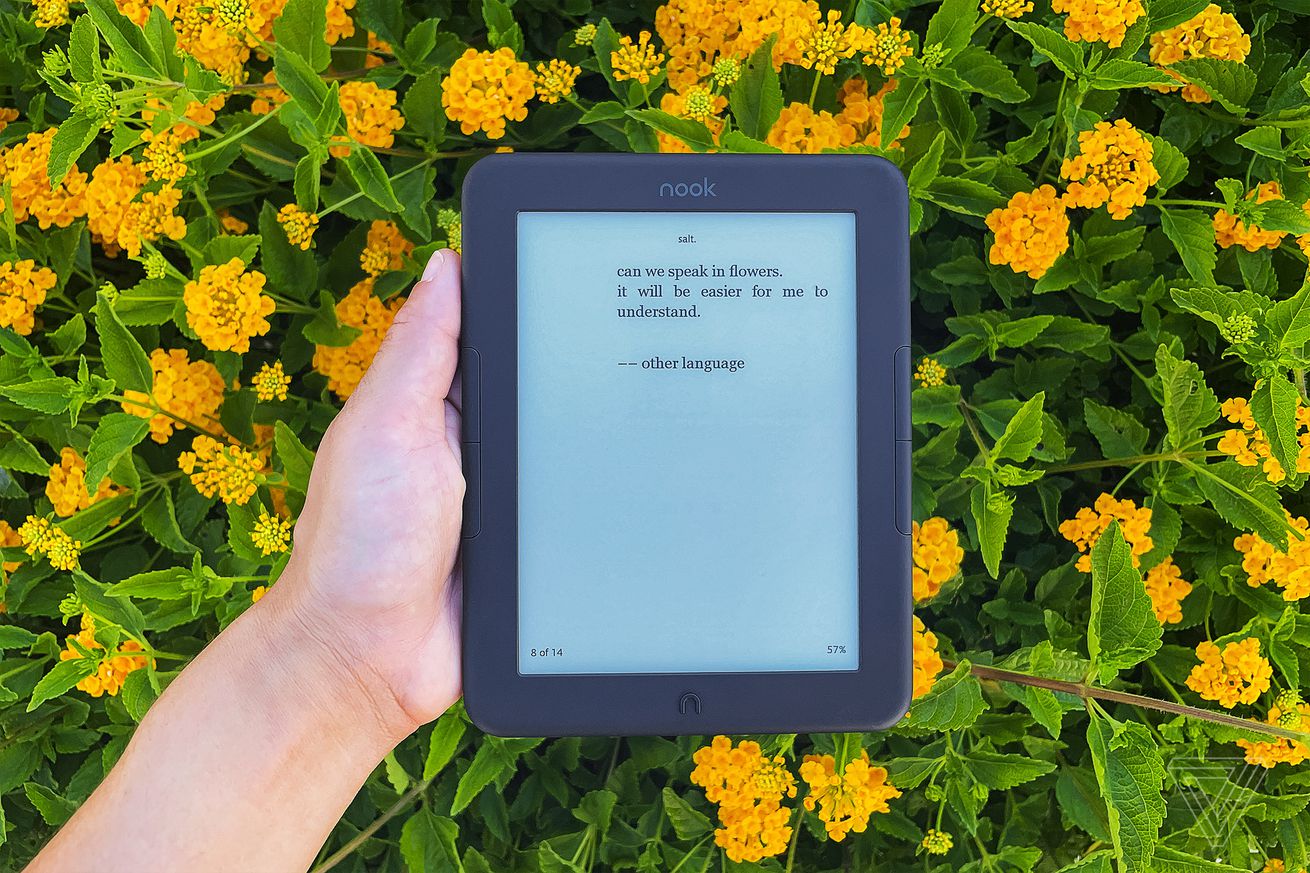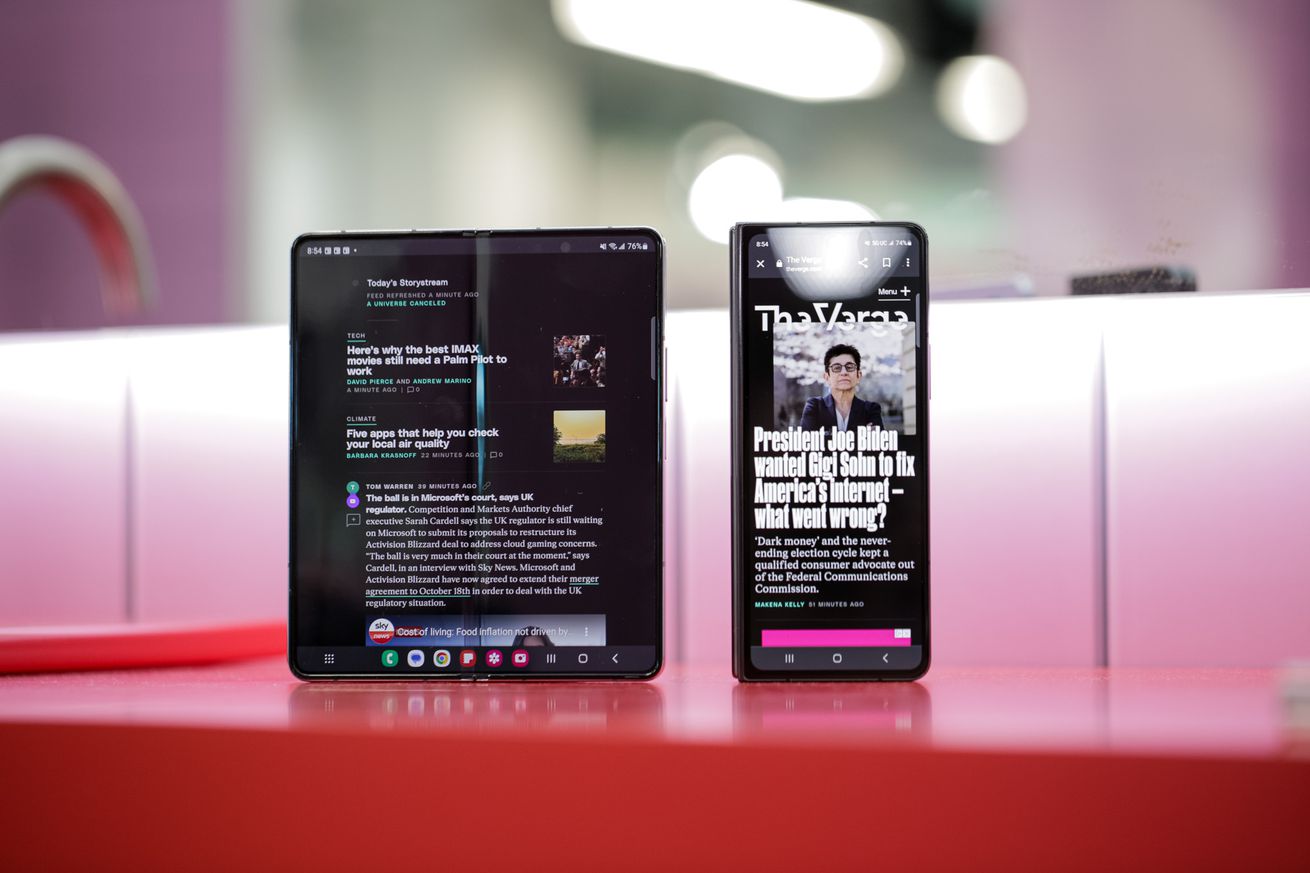
The company is looking to give its stores an indie bookstore vibe, but its e-readers have more of an Amazon Kindle in the early 2010s vibe.
My first e-reader wasn’t a Kindle, it was a Nook. It had a 6-inch 167 ppi E-Ink display and a tiny, terrible, but exciting LED display underneath. There was a headphone jack, wi-fi, and a music player built right in. Coming out a year before the iPad, it felt electric. It felt like Star Trek. It felt like the perfect bridge device between my smartphone and my computer. But soon Amazon turned its considerable might, and ability to subsidize its ebook business with all its other more lucrative businesses, against Barnes & Noble, and as it raced Amazon to the cheapest e-reader Barnes & Noble lost whatever identity its e-reader division was developing.
Now, years after Amazon won and Barnes & Noble lost, the company is privately held and it has a new CEO, James Daunt. Daunt was brought on in 2019 to help save the company that had been devastated by high rents on its stores, a precipitous decline in sales, and the aforementioned retail giant. Daunt’s vision for the indie bookstore killer approaches the ironic. The once giant of publishing is handing control of its stores to its managers, attempting to instill in each of its stores the independent spirit it used to quash. Wall Street Journal has a profile of the company out this week that’s a fascinating look at how Barnes & Noble is learning to compete with Amazon without cannibalizing itself in the process.
The Nook business doesn’t come up in the profile, and thats probably for the best. When you’re trying to rebrand your company as indie and cool you can’t show up with the Nook. While most e-readers are slim, with small bezels and sleek exteriors, the E-Ink part of the Nook line up looks like it stumbled out of 2012. Looking at it I feel the urge to ask the Glowlight 4 who the president is.
/cdn.vox-cdn.com/uploads/chorus_asset/file/23055555/nook.png) Image by Barnes & Noble
Image by Barnes & Noble
And I don’t think it’s supposed to be this way. When Daunt launched the $149 Nook Glowlight 4 in 2021 he said that the company was looking to “reinvigorate Nook in the coming months and years.” Since than the company released four ebook-reading devices. There’s the 10-inch Android tablet made by Lenovo, that...looks like every other $130 tablet. But at least it’s got the Google Play Store on the home screen so you can choose which e-reader app you use.
Then there are the E-Ink readers. The flagship is the Nook Glowlight 4 which is a little more expensive than the Kindle and a little cheaper than the Kobo, and few features lighter than both. But it does have page turning buttons! The $99 Nook Glowlight 4e has page-turning buttons too, but sacrifices even more than the Glowlight 4 to keep its price low. Namely the quality kind of sucks. We had lots of issues with responsiveness which is probably the most frustrating sin an e-reader can commit. If I press a button to turn the page...I need the page to turn.
In September Barnes & Noble is going to try and turn things around with the $199 GlowLight 4 Plus. It’s waterproof. It’s got a headphone jack and Bluetooth. There is 32GB of onboard storage and a front-lit E-Ink display with 300ppi resolution and color temperature control. It’s not that first generation Nook from way back in 2009, but it feels more exciting than what Amazon is offering at the same price.
The problem is, like the other Nook e-readers its kind of dorky, and if you’re already in the Kindle ecosystem—which a lot of people are—there’s not a super compelling reason to switch over beyond a desire to cut the Amazon cord or because you love buttons.
/cdn.vox-cdn.com/uploads/chorus_asset/file/24818149/Capto_Capture_2023_07_29_02_34_46_PM.jpg) Image by Barnes & Noble
Image by Barnes & Noble
The Nook lineup includes a couple of other features that should theoretically be compelling, but always come up just short. For example, you can access library books on the Nook, but keeping with the early 2010 theme of this lineup, you will need a USB cable and Adobe software. Meanwhile Overdrive can send books to your Kindle directly, and while it can be difficult to set up, Kobo has Overdrive built in.
It’s unclear how Daunt’s current “reinvigoration” of the Nook brand is going for the company financially, but from the outside I don’t see how it can be doing anything but breaking even. Anti-Amazon customers and Nook diehards who never switched can’t be that much of a market, and it also has to compete with Kobo to woo people opposed to Amazon—which analysts estimate owns between 68 and 83-percent of the ebook marketshare in the U.S.
With that kind of dominance Barnes & Noble either needs to fight over the scraps with Kobo (which is owned by Rakuten—the massive Japanese online retailer) or differentiate itself. Lackluster design and physical buttons aren’t gone be enough.
I’d love to see Amazon release an Android E-Ink tablet. These tablets are getting more popular in non-American markets where one two to companies don’t have a virtual monopoly on the e-reader space. You can buy one on Amazon or direct from the manufacturer pretty easily. I’m personally enamored with Onyx Boox and its line up of Android E-Ink tablets.
/cdn.vox-cdn.com/uploads/chorus_asset/file/24188515/226403_Onyx_Boox_Leaf_2_AKrales_0020.jpg) Photo by Amelia Holowaty Krales / The Verge
Photo by Amelia Holowaty Krales / The Verge
The problem is the software experience isn’t always very good, and most Android applications aren’t built for E-Ink displays with their glacially slow refresh rates. This leads to a lot of friction that doesn’t exist when you use a traditional tablet or phone.
But Barnes & Noble has a lovely app experience. It could theoretically do away with a lot of that friction. Imagine an e-reader that supported the Barnes & Noble store out of the box but allowed you to also access your Kindle library, or easily check out a book from Libby, or scroll through your bookmarked articles in Pocket too.
Amazon will never build a Kindle with that flexibility—it ones you to stay right in the Amazon ecosystem. Kobo is similar. There’s a reason downloading a library books isn’t as seamless as buying a booking from the Kobo store. But Barnes & Noble is the bookseller that wants to show off its independent spirit. It wants its brick and mortar stores to express their individualism. So why not its e-readers too?



/cdn.vox-cdn.com/uploads/chorus_asset/file/24815463/Screen_Shot_2023_07_28_at_11.48.09_AM.jpg) Image: Bloomberg
Image: Bloomberg
/cdn.vox-cdn.com/uploads/chorus_asset/file/24815457/Screen_Shot_2023_07_28_at_9.50.14_AM.jpg) Image: Bloomberg
Image: Bloomberg


/cdn.vox-cdn.com/uploads/chorus_asset/file/24814469/Screenshot_2023_07_27_at_3.55.11_PM.png)
/cdn.vox-cdn.com/uploads/chorus_asset/file/24814903/Screenshot_2023_07_27_at_6.19.19_PM.png)





/cdn.vox-cdn.com/uploads/chorus_asset/file/24809324/236733_Z_Flip_5_and_Z_Fold_5_BFarsace_0007.jpg) Photo by Becca Farsace / The Verge
Photo by Becca Farsace / The Verge
/cdn.vox-cdn.com/uploads/chorus_asset/file/24809325/236733_Z_Flip_5_and_Z_Fold_5_BFarsace_0008.jpg) Photo by Becca Farsace / The Verge
Photo by Becca Farsace / The Verge
/cdn.vox-cdn.com/uploads/chorus_asset/file/24751356/DSCF1743.jpg) Photo by Chris Welch / The Verge
Photo by Chris Welch / The Verge

/cdn.vox-cdn.com/uploads/chorus_asset/file/24809276/236731_Samsung_Galaxy_Watch_6_OGrove_0017.jpg)
/cdn.vox-cdn.com/uploads/chorus_asset/file/24809274/236731_Samsung_Galaxy_Watch_6_OGrove_0015.jpg)
/cdn.vox-cdn.com/uploads/chorus_asset/file/24809272/236731_Samsung_Galaxy_Watch_6_OGrove_0013.jpg)
/cdn.vox-cdn.com/uploads/chorus_asset/file/24809266/236731_Samsung_Galaxy_Watch_6_OGrove_0007.jpg)
/cdn.vox-cdn.com/uploads/chorus_asset/file/24809265/236731_Samsung_Galaxy_Watch_6_OGrove_0006.jpg)
/cdn.vox-cdn.com/uploads/chorus_asset/file/24809275/236731_Samsung_Galaxy_Watch_6_OGrove_0016.jpg)
/cdn.vox-cdn.com/uploads/chorus_asset/file/24809273/236731_Samsung_Galaxy_Watch_6_OGrove_0014.jpg)

/cdn.vox-cdn.com/uploads/chorus_asset/file/24810657/F18A7UuWAAALzsV.jpg) Image:
Image: /cdn.vox-cdn.com/uploads/chorus_asset/file/24810658/F18A7UuWIAIu4_p.jpg) Image:
Image: /cdn.vox-cdn.com/uploads/chorus_asset/file/24810636/Pasted_Graphic_2.png) Image:
Image: /cdn.vox-cdn.com/uploads/chorus_asset/file/24810637/Pasted_Graphic_3.png) Image:
Image: /cdn.vox-cdn.com/uploads/chorus_asset/file/24810642/Pasted_Graphic_7.png) Image:
Image: /cdn.vox-cdn.com/uploads/chorus_asset/file/24810641/Pasted_Graphic_6.png) Image:
Image: /cdn.vox-cdn.com/uploads/chorus_asset/file/24810640/Pasted_Graphic_5.png) Image:
Image: 